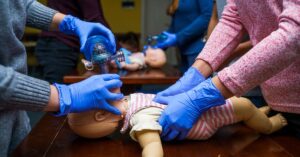Although our bodies are intricate organic machines that work tirelessly to function accurately, not all parts of the system are equal. Many of us would agree that the brain and heart are the most essential organs in our body. That is why it is the first thing healthcare professionals focus on when someone is in cardiac arrest.
However, each life-saving technique is different depending on the patient, and as a healthcare professional, you may need to know a specific one. Keep reading for the difference between a PALS and ACLS certification.
PALS
PALS is short for pediatric advanced life support; as you can guess, it is a procedure designed specifically to save the lives of children. It is certainly hard to think of a child or infant in distress, but unfortunately, that is sometimes a reality for healthcare professionals. However, we can thank the American Heart Association for developing various life-saving techniques. PALS allows for a provider to accurately administer life support to a child.
In our PALS course, you will learn how to save a child’s life. We teach you how to administer one and two-rescuer child/infant CRP and AED. We will also provide you with knowledge on managing respiratory emergencies, disturbances in rhythm, and electrical therapy. Moreover, we will teach you all you need about vascular access and pediatric assessment. We will also provide a variety of cases and simulations to prepare you for any situation.
ACLS
ACLS is short for advanced cardiovascular life support, and this life-saving technique treats adults in distress. The main difference between a PALS and ACLS certification is how the instructor teaches you how to provide life support. Often, ACLS will be much too rough for a child and could cause more harm than good. The main goal of ACLS is to treat various cardiopulmonary emergencies, like cardiac arrest in adults.
Our ACLS course will teach you how to manage respiratory and cardiac arrest, basic life support skills, and related pharmacology. Moreover, you will also learn how to recognize and manage peri-arrest conditions, airway management, acute coronary syndromes, and strokes. We will also teach you how to communicate as a leader or member of a resuscitation team, teaching you crucial team dynamics to help everything go as efficiently as possible.
Certification
While ACLS and PALS have a significant difference, they have one main thing in common: to save lives. Every healthcare facility needs to have advanced cardiovascular life support systems in place—it is essential. Moreover, every healthcare provider must know how to administer these life-saving techniques to each patient, regardless of age.
If you want to receive your PALS certification from trusted AHA instructors, look no further. CPR123 has everything you need to learn how to save lives. We even provide some of our classes online!







